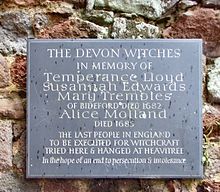Bideford Witch Trial
 From Wikiversity - Reading time: 4 min
From Wikiversity - Reading time: 4 min

Bideford Witch Trial is a research project initiated in November 2012
Introduction
[edit | edit source]The Bideford witch trial was the last prosecution of witches which resulted in a hanging in England. It took place in the Devonshire town of Bideford in 1682. Temperance Lloyd, Mary Trembles and Susannah Edwards were all hanged.
Bideford and the drugs trade
[edit | edit source]Bideford's growth as a port was connected to their involvement in the drugs trade. Sir Richard Grenville (1542 – 1591) came from Bideford and was a pioneer of the English invasion of North America. His colleague, Sir Walter Raleigh landed his first shipment of tobacco here. By the 16th century Bideford had become Britain's third largest port.[1] The town became prominent for the shipping of indentured servants who were the original source of labour for the new World Tobbacco industry.[2] The cost of indentured labor rose by nearly 60 percent throughout the 1680s in some colonial regions.[3] John Davie was a prominent drug dealer: For example in 1676, one ship, the Bideford Merchant, John Davie, Abraham Heiman and Anthony Hopkins imported 135,000 lbs of tobacco.[4]
Drug trade turf war
[edit | edit source]During the 1660's the price of tobacco was very low, which meant that the Virginia planters found it hard to make profits. So the Virginian House of Burgesses introduced official codes making the enslavement of Africans perpetual.[5]
Agnosticism Overcome
[edit | edit source]
Joseph Glanvill (1636–1680) was the seventeenth century author of Saducismus Triumphatus (1681). The title can be translated as "Agnosticism Overcome". This was an edition produced by Henry More, a Cambridge Platonist as was Glanville. Anthony Horneck (1641–1697), who had been vicar at Dolton, Devon until 1671 also contributed an appendix to the 1688 edition, which dealt with accounts of witchcraft in Sweden.
Islam and Seventeenth Century Devon
[edit | edit source]One aspect of the impact of Islam on seventeenth century Devon was the capture of the island of Lundy by Muslim corsairs in 1627. They held it for five years until 1632. Jan Janszoon a Dutch Muslim led the fleet which captured the Island - which is located about 20 miles off the Devon coast just by Bideford. During the period of occupation he conducted various slave raids in the area and also as far a field as Iceland. Between June 20 – July 19 1627 about 400 people from Iceland were captured and enslaved in what is known as Tyrkjaránið (Turkish Abductions). In June 1631 he led the Sack of Baltimore, a raid on an English protestant settlement. The raid led to a response by the English which may have led to Janszoon being driven off Lundy.
The figure of Caliban
[edit | edit source]- "Temperance was brought to confess that she had met the devil, as a little blackamoor, in a lane, and that she had gone with him invisibly to the bedroom of Grace Thomas, who lodged in the house of Thomas Eastchurch, and that she "did then and there pinch with the nails of her fingers the said Grace, in her shoulders, thighs, and legs." She further admitted that the black man had sucked her teats, and that he was about the length of her arm."
This image of the devil as "a little blackamoor" may seem curious in a small country town such as Bideford appears today. However at the time Bideford was one of the major ports in England. Her wealth was very much tied up in the tobacco trade, a commodity grown on plantations in the Americas using enslaved African labour. Caliban
Sources
[edit | edit source]On-line
[edit | edit source]Fibre-space
[edit | edit source]- Baring-Gould, Sabine (1908). Devonshire Characters and Strange Events. London: John Lane.
- Federici, Sylvia (2004) Caliban and the Witch: Women, the Body and Primitive Accumulation. Brooklyn, NY: Autonomedia.
- Galenson, David (March 1984). "The Rise and Fall of Indentured Servitude in the Americas: An Economic Analysis". The Journal of Economic History 44 (1): 1–26.
- Gent, Frank (1982). The Trial of the Bideford Witches.
References
[edit | edit source]- ↑ "The Beautiful North Devon Town of Bideford". Bideford Town Council. 2010. Retrieved November 18, 2012.
- ↑ "The south west ports of England". Bristol City Council. Retrieved November 18, 2012.
- ↑ Galenson 1984, p. 1–26.
- ↑ The Tobacco Trade, Bideford 500 Accessed 28 November 2012
- ↑ Bacon's Rebellion Virginia places accessed 30th November 2012
 KSF
KSF